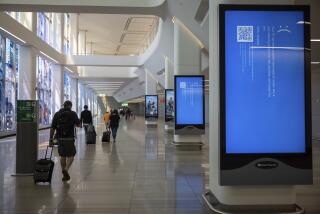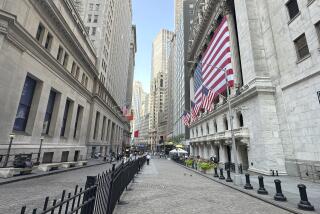HOURS OF BEDLAM IN A NEW YORK MINUTE
- Share via
NEW YORK — In an instant, Manhattan plunged back in time. Powerless, New Yorkers emerged into a heat-choked city where even the usual tumult of an afternoon commute was strained to the breaking point. As night fell and the city eased, waiting for the lights to return, the silhouettes of darkened skyscrapers loomed like distant hills over Central Park.
Without neon or subways or air-conditioning, New Yorkers endured with quick wits, strong legs and their typical toughened courtesy. But, tough as they were, many spent their first minutes of Thursday’s blackout wondering if their city had been revisited by the horrors of Sept. 11.
“There was a look in people’s eyes,” said Kim Cappachione, a financial planner who stumbled out a Wall Street tower minutes after the power went out. “You didn’t want to talk about it. You wanted to believe it was natural.”
Moments after the lights went out at 4:15 p.m. EDT, workers in Manhattan’s warren of office towers wasted no time in getting down to the ground. They stampeded through stairwells. Police and firefighters responded to numerous reports of people trapped in stalled elevators.
At the Empire State Building, Manhattan’s tallest structure ever since two airliners brought down the twin World Trade Center towers nearly two years ago, workers and visitors had a long, harrowing descent. Office worker Allan Feldman said he walked down 21 flights of stairs because some elevators were not working.
“We could hear people pushing buttons on the way down,” he said.
At the end of their long descents, these New Yorkers confronted a city where nothing worked. Buses, clogged with passengers, groaned through traffic that inched forward in agonizing spurts. At intersections where traffic lights had winked out, pedestrians darted through traffic like bull runners at Pamplona.
Stranded subway commuters lifted manhole covers to force their way out of darkened tunnels. Office workers became traffic cops, directing bemused pedestrians like orchestra conductors. Feet replaced engines, as car-strewn boulevards and bridges metamorphosed into 19th century promenades. Hikers toted backpacks and water jugs for commutes that stretched on for miles of city blocks.
Electric-powered subways and trains ground to a halt. Those who walked out under the brutal afternoon sun were lucky. Thousands more had to gingerly exit through dimly-lighted subway and train tunnels.
For the most part, the processions were orderly and calm. Transit conductor Ray Lynch was one of several dozen subway workers who led 800 stranded riders up to daylight from a D train that lurched to a stop under West 68th Street. Even in a “pitch-black tunnel, with no air-conditioning,” passengers “stayed very calm. There was no panicking,” Lynch said, even as flashlight-toting crews shepherded them toward the street.
Some passengers lucky enough to learn early on about the blackout’s national dimensions took their plight in stride. When Patrick Anderson, 38, informed his fellow riders after he learned over his cell phone about the widespread outage from a friend in California, they were “all very chivalrous -- women and children first.”
But Ken Goldberg, 46, another subway survivor, had to endure the frantic uncertainty that gripped many passengers. In his packed subway car, everyone seemed to assume the worst -- and some lashed out in response. One surly passenger smashed open a window to get some air -- then promptly lit a cigarette, violating the city’s anti-smoking ordinance.
“First 9/11, now this -- I’m getting out of this city,” Goldberg said
Visitors, too, were shaken. Among the hordes stranded downtown was Tara Prig, 14, who had traveled with her family from South Orange, N.J., to spend time on Broadway.
“We have no idea how we are going to get home,” she said. Asked if she was frightened, she said: “A little bit.... The most amazing thing I ever saw was to walk down Times Square and see all of the screens empty.”
Elaine Sullivan, a tax auditor from Ronkonkoma, N.Y., was taking the day with a classic New York fatalist’s airs. She had been headed for the 4:24 train at Penn Station when the power blanked out. As the world seethed around her, she stood quietly in her sleeveless dress and high heels, reading John Grisham’s “The Testament.”
“What else can you do?” she shrugged. “Getting crazy isn’t going to do anything.”
But in other parts of Manhattan, getting crazy was the only way to travel.
The Brooklyn Bridge became a densely-packed procession of fleeing office workers. Burly cops in sweat-stained uniforms glowered from the bridge’s cement catwalk as the flood of humanity made its way across the East River toward an equally-darkened Brooklyn Heights.
“We’ve seen it all,” said Mike Rogalle, a UPS deliveryman whose van was frozen by the snarled traffic outside City Hall in Lower Manhattan. His brown uniform shirt was stripped open and streaked with perspiration. “A terrorist attack, snowstorms, protests -- and now a power outage.”
On East 38th Street, seven people sat on the steps of a brownstone drinking white wine. Motorists in their idled cars stared enviously.
“We are so jealous,” said a woman driving an SUV.
“We are being invited to a dinner party. No one is coming,” said one of the partyers, Michelle James, 41, a job recruiter in the media industry. She said a neighbor had invited 25 guests. None showed up.
A tired Nadia Stirratt, who works for an Internet company, finally joined the group. She said she had walked down six stories in her building in lower Manhattan and had walked uptown to see her friends.
“I am numb from the ankles down,” she said, adding: “My husband is in a plane trying to land at JFK” airport. The airport was closed for hours by the power outage.
Near Penn Station, two men buried themselves in a chess game while pedestrians hurtled around them. An irate crowd surrounded a jammed Queens-bound Metropolitan Transit Authority bus, insistent that more room could be found.
A no-nonsense policewoman waded through, bellowing. “Form a line!” she shouted. “If you can’t work together, the bus won’t move! Nobody is getting on this bus until people get on the sidewalk.”
But when the bus doors creaked open, the mob surged forward until the frightened driver slammed them shut again. The policewoman’s partner watched in amazement.
“Everyone here is animals!” he said.
Some New Yorkers found themselves facing problems they had never encountered, not even after the terror attacks of two years ago. Those desperate to find cash or use plastic were out of luck. Credit card verification systems were not working at the few restaurants and bars that remained open. Automatic teller machines had gone dark all over town.
As darkness fell in Manhattan, after 8 p.m., huge numbers of people still lingered on the streets. Few buildings were lit -- just those with emergency generators. The only steady lights on the streets were the flickering of headlights from cars still caught in gridlock as they tried to flee the city.
On Fifth Avenue, where shoppers and lovers normally hold sway at night, the shops were swathed in darkness, illuminated only by flashlights carried by people heading home.
They had all the time in the world in a city that had gone to bed early.
But the night brought out the best in those who stayed awake. One Good Samaritan with a light stood guiding people groping in the dark toward a ferry landing. And as a taxi cruised in the shadows down a blackened street in Lower Manhattan, the driver called out into the darkness.
“Anybody going to Brooklyn? Come on in!”
More to Read
Sign up for Essential California
The most important California stories and recommendations in your inbox every morning.
You may occasionally receive promotional content from the Los Angeles Times.










